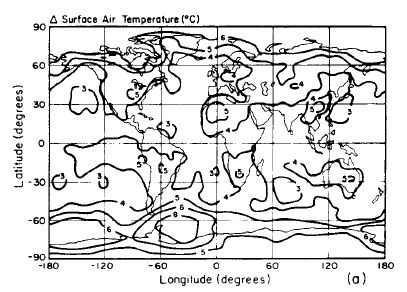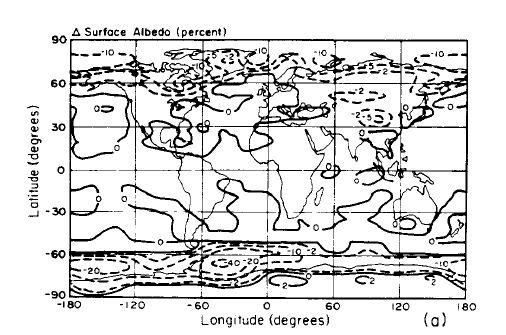The map below shows Hansen’s forecast temperature change for a doubling of CO2.
Note that the fastest warming place on the planet is forecast to be Antarctica at 5-8C
The map below shows his forecast for albedo loss (i.e. ice loss.)
Note that the worst location for ice loss was again supposed to be Antarctica, with as much as 40% loss.
So how are his forecasts doing so far? Antarctica has cooled and gained ice over the last 30 years.




The Church of Climatism; junk data in, junk science out.
Sorry Steve, you’re plain wrong here. Look at the outline of the continents. The hotspots for both warming and albedo change are in the sea off the Antarctic Peninsula. The forecast for Antarctica itself is for less than 5 degrees air temperature rise and less than 2% albedo change.
He was still wrong then .
The area East of the Antarctic Peninsula has gained ice, and continent wide temperatures have dropped.
“The Antarctic Peninsula is a part of the world that is experiencing extraordinary warming.” See
http://en.wikipedia.org/wiki/Antarctic_Peninsula#Climate_change
and the references therein.
The book chapter from Hansen you cited says:
“We are left in the very unsatisfactory position of having clear evidence that important climate effects are imminent but not having the knowledge or tools to specify these effects accurately. The principal areas of uncertainty include the equilibrium climate sensitivity, especially the contribution of clouds, and the nature of the transient climate response, which depends on storage and transport of heat by the ocean,
including the feedbacks that may occur with changing climate at the ocean surface.”
How can he be wrong when CO2 has not yet doubled?
Pre-industrial = 280 ppm
Current = 390 ppm
Doubling = 560 ppm
We’re not even half way there yet, and you can’t do a calc without factoring in feedbacks/time.
Wa-a-a-ay too premature to make a call.
Not the first time Steve has gone off prematurely.
not the first time Brendon has talked like a know it all
The trends are in the wrong direction. If you start driving towards LA, you don’t end up in New York. Climate science is not excluded from the laws of physics, though they attempt it all the time.
That really depends on the driver and your starting point – but your analogy is really really bad to begin with.
And I know you like to focus of what Hansen said 22 years ago, but how does this stack up against other peoples predictions using more current information?
Is what Hansen said 22 years ago even relevant today? Climatologists know more about the climate now than back then and the climate models are certainly more sophisticated.
If you don’t trust climate forecasts from 22 years ago, why would you trust ones for 9o years in the future?
I trust that the current ones are better than the older ones.
I also know that the models have predicted the effect of some global events in the past. See Pinatubo
But again Steve, you’ve only answer part of the question. You really like avoiding the harder part. What are other scientists saying now, do they still agree with Hansen now or have they learnt more about the climate?
Hansen is still talking about an Antarctic meltdown. Where do you think his 3-6 metres of sea level rise comes from?
Can you finish one conversation first or do you suffer from ADHD?
Brendon,
Please feel free to find us an IPCC member who openly contradicts Hansen. You are a big boy and don’t need to be spoon fed.
Oh that’s tooooo easy Steve.
Where in the IPCC report does it mention sea levels like Hansen’s “3-6 metres”?
“The trends are in the wrong direction. ”
Aren’t they supposed to be initially? Hasn’t an increase in ice at the Antarctic long been predicted as a sign of Global Warming?
Increased temps case more precipitation (snow) causing more ice build up initially, until temps are too high for this to happen.
But your comments seem to be only valid for ice extent not the actual amount (mass) of ice, which is declining.
http://www.sciencemag.org/cgi/content/abstract/311/5768/1754
http://www.agu.org/pubs/crossref/2009/2009GL040222.shtml
http://www.nature.com/ngeo/journal/v2/n12/full/ngeo694.html
So what you are saying is there is a consensus in the climate science community that Hansen is wrong.?
How can he be wrong when CO2 has not yet doubled?
Pre-industrial = 280 ppm
Current = 390 ppm
Doubling = 560 ppm
I think it’s even worse than that. Using Steve’s 1980 start point, it’s not a valid comparison until we double the 1980 CO2 level–not the pre-industrial level.
1980 = 339
Doubling = 678
Current = 390
We’re only 15% of the way toward a doubling of 1980 levels.
Or, as Bob Uecker said in Major League, “juuuuuust a bit outside.”
When Hansen and other climate scientists refer to doubling CO2, they are talking about a doubling from pre-industrial levels of 280 ppm. We are 40% of the way there.
If you are driving in the wrong direction, you do not end up at your destination. Climate science does not get a waiver from the standard laws of physics.
We’re only 15% of the way toward a doubling of 1980 levels.
I doubt your numbers.
But let’s triple it. We need some cooling.
Good find here Steve.
I’ve been trying to follow how Hansen’s climate science has changed over time and here is another to add the library.
Besides the obvious Antarctic warming failure (that they have mostly successfully rewritten over the last few years as never predicted in the first place), the tropical hotspot in this paper is much higher than the current maps show and there is another little gem about a decline in the lapse rate by -0.2C/km – which I have always wondered how they could leave that at the same number – it should be physically impossible to remain at the same number and should decline – it seems even Hansen recognized that at the beginning.
To put that in perspective, if the current projections for the troposphere in the models are correct, a -0.2C/km change in the lapse rate would have the surface only warming by half or 1.5C. Well, today, there is no tropical hotspot and very little warming in the troposphere and there are predicting the lapse rate to stay more-or-less constant.
Of course the science changes over time. Where the warming will be fastest and various other effects are not perfectly understood. Our knowledge is better than is was is 1988. While there are many open questions (e.g., the impact on storms, and the rate of glacier melting), it is clear the world is warming b/c of our GHG emissions.
Re Brendon
That’s one interpretation. Which climate model predicted Pinatubo? Your interpretation (and your rather unreliable source) rely on a rather unusual definition of ‘prediction’. If you read Hansen’s 2007 paper discussing GISS-E you’ll see this-
The simulated global LS warming following the 1991 Mt. Pinatubo eruption agrees closely with observations, which is an improvement over the model results of Hansen et al. (2002).
So their model ‘predicted’ it more skillfully more than a decade after the event. Predicting the past isn’t as useful as the more usual predicting future events reliably.
The models are getting more accurate, you’d expect that but thanks for highlighting it again for me.
This is somewhat related — just a reminder of what people were saying in 2007 about Arctic ice melt — there are others but this is probably one of the most over the top:
“Louis Fortier, scientific director of ArcticNet, a Canadian research network, said the sea ice is melting faster than predicted by models created by international teams of scientists, such as the Intergovernmental Panel on Climate Change. …..”
… According to these models, there will be no sea ice left in the summer in the Arctic Ocean somewhere between 2010 and 2015.
“And it’s probably going to happen even faster than that,” said Fortier, who leads an international team of researchers in the Arctic looking for clues to climate change. …
–Times Colonist (Victoria) November 16, 2007
I just love those “yeah but the forecast NOW are better”.
Really? Did you jump back from the future to tell us that?
Pingback: Si squaglia il gelato, anzi, no. | Climate Monitor
Brendon says: “The models are getting more accurate, you’d expect that but thanks for highlighting it again for me.”
The Ptolemaic models of the solar system also got more accurate every generation. They were still dead wrong, Brendon. The Sun goes at the center.